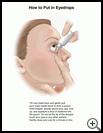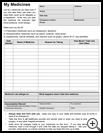
Loteprednol Etabonate, Ophthalmic
loh-te-PRED-nol eh-TAB-oh-nate
________________________________________________________________________
KEY POINTS
- This medicine, in the form of eyedrops, is used to treat inflammation of the eyes caused by allergies, bacteria, viruses, or eye surgery. Use it exactly as directed. Do not use more or less or use it longer than prescribed. Using this medicine for a long time may cause glaucoma or cataracts.
- Keep all appointments for tests to see how this medicine affects you.
- This medicine may cause unwanted side effects. Tell your healthcare provider if you have any side effects that are serious, continue, or get worse.
- This medicine may cause life-threatening problems if you take this medicine with certain other medicines. Tell all healthcare providers who treat you about all the prescription medicines, nonprescription medicines, supplements, natural remedies, and vitamins that you take.
________________________________________________________________________
What are other names for this medicine?
Type of medicine: corticosteroid
Generic and brand names: loteprednol, ophthalmic; Alrex; Lotemax
What is this medicine used for?
This medicine, in the form of eyedrops, is used to treat inflammation of the eyes caused by allergies, bacteria, viruses, or eye surgery.
This medicine may be used to treat other conditions as determined by your healthcare provider.
What should my healthcare provider know before I take this medicine?
Before taking this medicine, tell your healthcare provider if you have ever had:
- An allergic reaction to any medicine or to benzalkonium chloride
- Cataract surgery
- Glaucoma
- Fungal or viral eye infections
Females of childbearing age: Talk with your healthcare provider if you are pregnant or plan to become pregnant. It is not known whether this medicine will harm an unborn baby. Do not breast-feed while taking this medicine without your healthcare provider's approval.
How do I use it?
Check the label on the medicine for directions about your specific dose. After surgery, your eyecare provider may recommend that you use a different bottle or eyedrops for each eye. Follow your healthcare provider's directions carefully. Do not use more or less or use it longer than prescribed. Do not stop using this medicine until your healthcare provider tells you to do so.
Check with your healthcare provider before using this medicine in children under age 18.
The eyedrops come in two strengths: 0.2% (Alrex) for minor inflammation and 0.5% (Lotemax) for more severe inflammation and for use after surgery. The gel and ointment come in one strength (0.5%; Lotemax) and are used after surgery.
You should not wear contact lenses while using Lotemax eyedrops, gel, or ointment. If you have Alrex drops and wear contact lenses, take them out before using this medicine. Do not put contacts back in for at least 10 minutes after using Alrex. Do not put your contacts back in if your eyes are red.
If you have the eyedrop or gel form of this medicine, shake the medicine well each time before you use it. Wash your hands thoroughly before and after applying the medicine. Tilt your head back slightly, and gently pull your lower eyelid down to form a pouch. Hold the dropper directly above your eye, look up, and the put the number of drops prescribed into the pouch. Close your eye for a minute or two. With a fingertip, press gently on the inside corner of your eye to keep the medicine from draining out.
To keep from contaminating the medicine, do not touch the tip of the dropper to your eye or any other surface. If this medicine is contaminated it may cause serious eye infections. Put the cap on tightly. Do not share eye medicine with other people. Do not use discolored eyedrops.
If you are using any other eyedrops, wait at least 10 minutes between applications of the medicines.
If you have the ointment form of this medicine, gently pull down your lower eyelid to form a pouch. Squeeze a 1/2-inch ribbon of ointment into the pouch. Let go of your eyelid and keep your eyes closed for a minute or two.
What if I miss a dose?
If you miss a dose, use it as soon as you remember unless it is almost time for the next scheduled dose. In that case, skip the missed dose and use the next one as directed. Do not use double doses. If you are not sure of what to do if you miss a dose, or if you miss more than one dose, contact your healthcare provider.
What if I overdose?
An acute overdose of this medicine is not likely to cause life-threatening symptoms. If you think that you or anyone else may have taken too much of this medicine, call the poison control center at 800-222-1222.
What should I watch out for?
Using this medicine for a long time may cause glaucoma (increased pressure in the eyes) or cataracts. Talk with your healthcare provider about this.
Your vision may be blurred for a short time after you apply the drops. Do not drive or operate machinery until you can see clearly. Also, this medicine may make your eyes more sensitive to bright light. Wear sunglasses outdoors.
If your condition does not improve in 2 to 3 days or gets worse, contact your healthcare provider. Your healthcare provider may want to check your eyes regularly if you use this medicine for more than 10 days. Keep all appointments for eye exams.
If you injure your eye, contact your healthcare provider right away. Eye injuries may be slow to heal while using this medicine.
Do not use other products in your eyes while you are using this medicine without your healthcare provider's approval.
If you need emergency care, surgery, lab tests, or dental work, tell the healthcare provider or dentist you are using this medicine.
What are the possible side effects?
Along with its needed effects, your medicine may cause some unwanted side effects. Some side effects may be very serious. Some side effects may go away as your body adjusts to the medicine. Tell your healthcare provider if you have any side effects that continue or get worse.
Life-threatening (Report these to your healthcare provider right away. If you cannot reach your healthcare provider right away, get emergency medical care or call 911 for help.): Allergic reaction (hives; itching; rash; trouble breathing; chest pain or tightness in your chest; swelling of your lips, tongue, and throat).
Serious (Report these to your healthcare provider right away.): Worsening of inflammation, signs of infection, changes in your vision, discharge, eye pain or swelling.
Other: Temporary burning or stinging, dry or red eyes, feeling that something is in your eye, itching, sensitivity to light, blurred vision, headache, runny nose.
What products might interact with this medicine?
No significant drug interactions have been reported. However, be sure that your healthcare provider knows about any other products you are using in your eyes.
If you are not sure if your medicines might interact, ask your pharmacist or healthcare provider. Keep a list of all your medicines with you. List all the prescription medicines, nonprescription medicines, supplements, natural remedies, and vitamins that you take. Be sure that you tell all healthcare providers who treat you about all the products you are taking.
How should I store this medicine?
Store this medicine at room temperature. Keep the container tightly closed. Protect it from heat, high humidity, and bright light.
This advisory includes selected information only and may not include all side effects of this medicine or interactions with other medicines. Ask your healthcare provider or pharmacist for more information or if you have any questions.
Ask your pharmacist for the best way to dispose of outdated medicine or medicine you have not used. Do not throw medicine in the trash.
Keep all medicines out of the reach of children.
Do not share medicines with other people.
Last modified: 2016-07-08
Last reviewed: 2016-07-01


